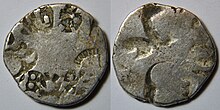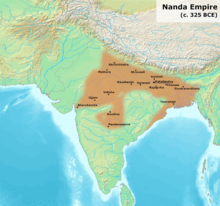| Mahapadma Nanda | |
|---|---|
 A silver coin of 1 karshapana of King Mahapadma Nanda or his sons 4th century BCE | |
| 1st Nanda Emperor | |
| Reign | c. 345 BC – 329 BC |
| Predecessor | Mahanandin |
| Successor | Panduka |
| Died | 329 BCE |
| Issue | 8 sons (including Dhana) |
| Dynasty | Nanda |
| Father | Mahanandin |
Mahapadma Nanda (IAST: Mahāpadmānanda; c. mid 4th century BCE), (died 329 BCE) according to the Puranas, was the first Emperor of the Nanda Empire of ancient India. The Puranas describe him as a son of the last Shaishunaga king Mahanandin and a Shudra woman. These texts credit him with extensive conquests that expanded the Empire far beyond the Magadha region. The different Puranas variously give the length of his reign as 28 or 88 years, and state that his eight sons ruled in succession after him.
The Buddhist texts don't mention him, and instead name the first Nanda ruler as robber-turned king Ugrasena, who was succeeded by his eight brothers, the last of whom was Dhana Nanda.
